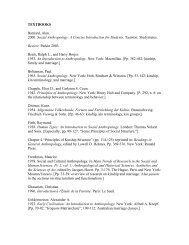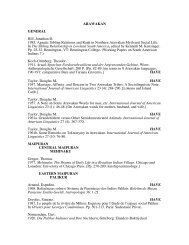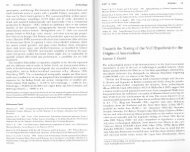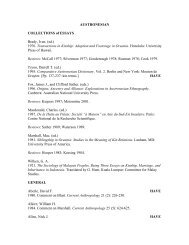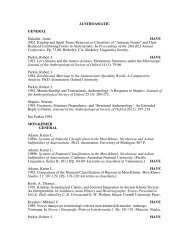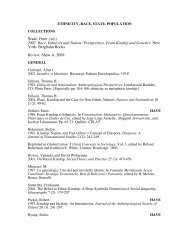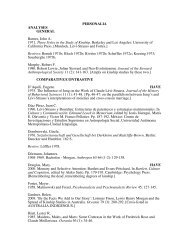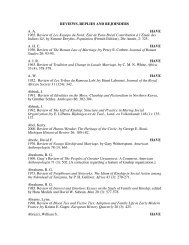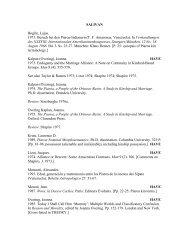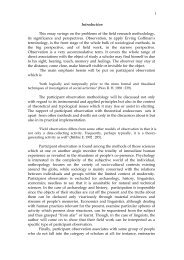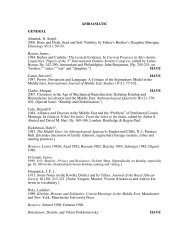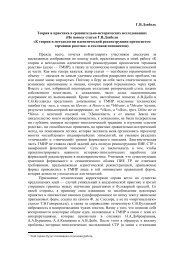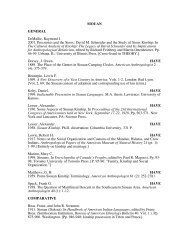On The Heterogeneity of Social Development - Kinship Studies
On The Heterogeneity of Social Development - Kinship Studies
On The Heterogeneity of Social Development - Kinship Studies
Create successful ePaper yourself
Turn your PDF publications into a flip-book with our unique Google optimized e-Paper software.
<strong>The</strong> history <strong>of</strong> the Indianist movement in Russia may be dividedinto four stages. <strong>The</strong> first stage spans the period from the end <strong>of</strong> the1960s to 1979 and is characterized by early contacts betweenindividuals and small companies <strong>of</strong> friends confined to their localities.<strong>The</strong> second stage (1980-1984) is renowned for the communal, or Pow-Wow solidarity which imbued Indianists. <strong>The</strong> years 1985-1986 may bemarked out as a third period <strong>of</strong> the Indianist community development.Total consciousness was outmoded at that time by the formation <strong>of</strong>small and stable groups.Striving to reach a full fusion with nature and the Indian way <strong>of</strong>life, people from Ukraine, Novosibirsk and St. Petersburg foundedrural settlements in the Altai Mountains and in the Crimea Peninsula.In 1986, on the wave <strong>of</strong> an extensive mass media campaign, severalIndianist activists formed the Leonard Peltier Support Group in St.Petersburg whose main concern was an assistance in setting free froman American prison one <strong>of</strong> the leaders <strong>of</strong> the American IndianMovement. Small manifestations, collecting <strong>of</strong> signatures,consultations with lawyers, meetings with the members <strong>of</strong> a likemindedgroup from the U.S. led by Leonard Peltier’s wife, petitions tothe governmental structures formed the range <strong>of</strong> the actions <strong>of</strong> thisgroup. By 1989 it exhausted the resources <strong>of</strong> action and ceased toexist.<strong>The</strong> period <strong>of</strong> 1987-1990 forms the fourth stage which wascharacterized by a 75% increase in the Indianist membership. By allmeans, this process bears connection to the sociopolitical changesinitiated in Russia at that time. More social freedom, more means <strong>of</strong>advertisement, more access to international contacts becameavailable. Many serious books on Indian culture and spiritualitystarted to mushroom in Russia. Russian cinema and video marketswere being filled with movies which authentically portrayed Indiancultural heritage and historical fate. In their turn, the literature andthe movies were launched by the overall tendency to reassess themodernistic attitude towards indigenous population and nature,which had emerged in the Euro-American society after World War II.<strong>The</strong> third stage can be viewed as a revival and redoubling <strong>of</strong> thecommunal solidarity <strong>of</strong> the second phase which likewise was followedby group and individual segregation and group and individualundertakings (1991-1996). In 1990 Indianists started a big publishingcampaign which gave rise to a good amount <strong>of</strong> <strong>of</strong>ficially recognisedjournals, among which Iktomi (published in Moscow since 1994),Tomahawk (Syktyvkar, 1990-1994), American Indian News (Moscow,1990-1993) and <strong>The</strong> First Americans (St. Petersburg, since 1996)occupy a pre-eminent place, and Russian translations <strong>of</strong> the classicalethnographic literature on North American Indians (North AmericanIndians series). About the same time, <strong>The</strong> Band <strong>of</strong> Indian Dances andSongs was formed on the basis <strong>of</strong> the St. Petersburg group withseveral invited participants from Moscow, Minsk and Ukraine. Due tosponsorship, the band succeeded in making a tour to Siberia but49



